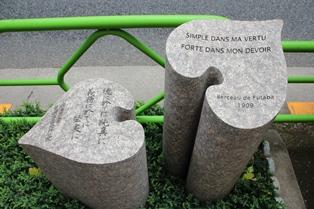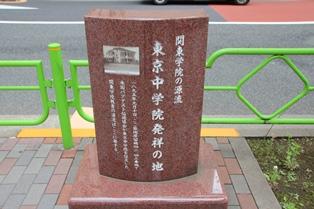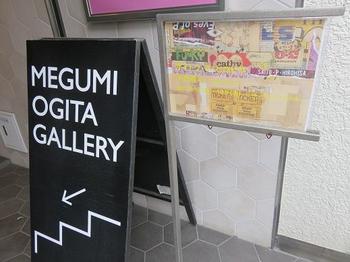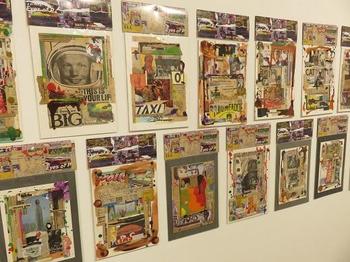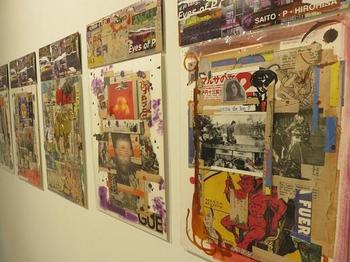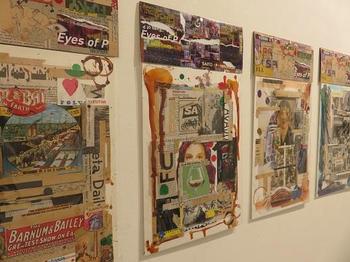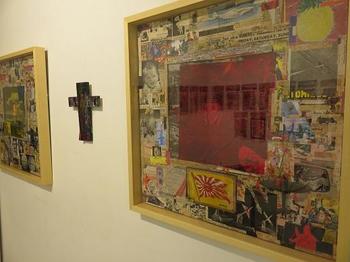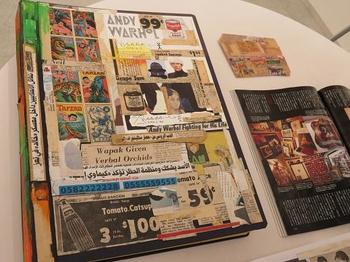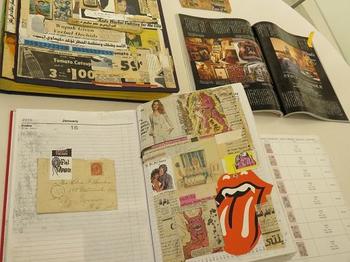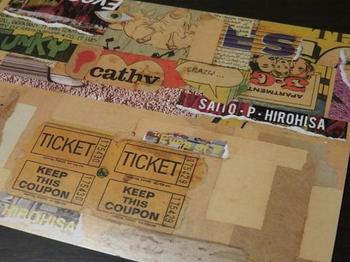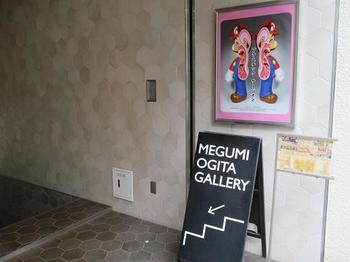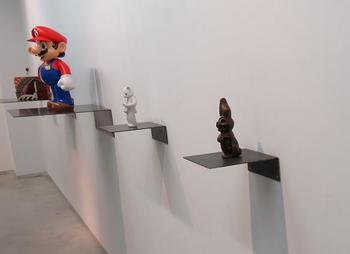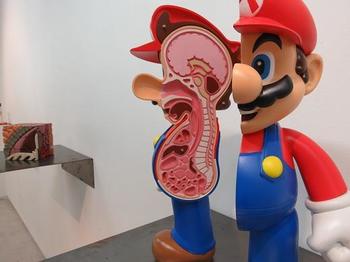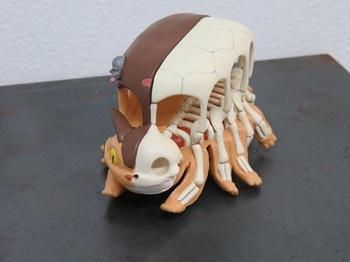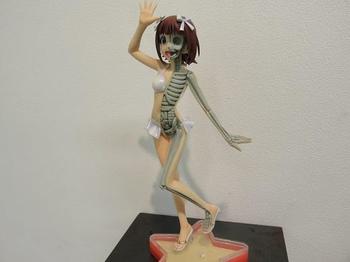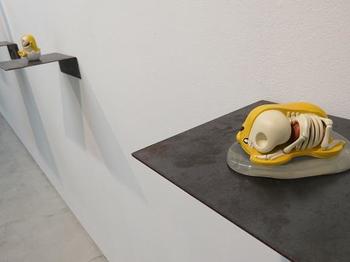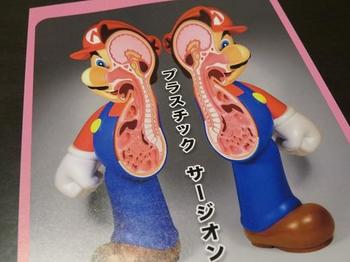갑옷바시 게시판에는 타니자키 준이치로의 유소년 시절이 인용되고 있다.이 인용된 부분의 전후에는 주변의 풍경이 잘 묘사되고 있다.
갑옷 다리는 1872년(1872)에 가교1888년(1888)에는 철골제의 트라스 다리로 교체되어 다이쇼에서 쇼와에 걸쳐 다리 위를 시덴이 달린 적도 있다.1957년 (1957)에 현재의 것으로 교체되었다 (『모노백과』; 26) '어린 시절'은 1955년(1955) 4월부터 이듬해 3월까지 잡지 '문예춘추'에 연재된 것이기 때문에 '갑옷 다리는 노후해서 제거되었다고 한다'라고 말한 것은 이 교체 전일 것이다.
다니자키가는 단기간 하마마치로 옮긴 후, 미나미카바초로 이전했다.
《어린 시절》이 인용되고 있는 갑옷 다리 설명판
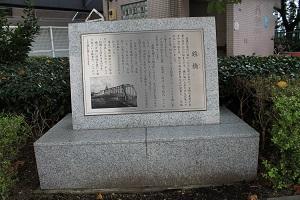
하마마치의 집에는 나는 불과 몇 달 있었을 뿐, 1891년 가을까지의 사이에, 미나미카바초의 45번지로 옮겨진 것 같다.・・・・・
・・“갑옷 다리는 옛날에는 갑옷을 건네라고 해서 내일은 다리가 없었던 것이다”라고, 어릴 적에 들은 적이 있었지만, 지금은 하류에 지바교라는 다리가 생겨서 갑옷교는 노후해서 뜯겨져 버렸다고 하니 다시 내가 태어나지 않았던 옛날에 돌아온 것이다.
고아미쵸 쪽에서 와서 원래의 갑옷 다리를 건너면, 우측에 투구쵸의 증권 거래소가 있지만, 좌측의 최초의 거리를 오모테 지바초라고 하고, 거기에 병행한 다음 거리를 뒷면 지바초라고 하고 있었다.・・・・・・・
가야바마치에 오고 나서도, 어머니나 할머니에게 이끌려 매일같이 본가에 놀러 가는 것은 변함이 없었다.거리는 하마마치 때와 거의 같은 정도로, 5, 롯쵸 정도였을 것이다.우라지바쵸에서 카츠미의 요코쵸를 오모바쵸로 나가, 갑옷 다리를 건너 고아미쵸 쪽으로 좌회전하고, 또 곧바로 우회전해 요네야쵸를 지나간다.나 야바야의 다리라도 15분 정도의 길이었고, 전철도 자동차도 없는 시대였지만, 갑옷 다리를 넘을 때는 넓은 왕래를 향하는 측의 인도 쪽으로 건너야 하기 때문에, 인력거에 치우치지 않도록, 할머니는 평생 열심히 나에게 주의했다.그 때의 다리는 노면보다 한층 높고, 경사가 붙어 있었기 때문에, 다리에서 걸어 내려오는 인력거는 타성으로 급정거할 수 없고, 의외로 위험한 일이 있었다.갑옷교는 그 무렵 시중에 그렇게 많지 않은 철교의 하나로, 아직 신대교나 영대교 등은 낡은 키바시 그대로였던 것 같다.나는 왕복으로 다리 도중에 멈춰서, 니혼바시 강의 물줄기를 바라보는 것이 항상 있었지만, 철의 난간에 얼굴을 밀어붙여 다리 아래에 나타나는 물의 면을 채우고 있으면, 물이 흘러가는 것이 아니라 다리가 움직이는 것처럼 보였다.나는 또, 지바쵸 쪽에서 건너, 상류의 투구읍의 기슭에 있는 시부자와 저택의 가야 이야기 같은 건물을, 언제나 이상한 마음으로 지칠 수 없이 바라본 것이었다.지금은 봄에 일증 빌딩이 세워져 있지만, 원래는 그 강연의 코에, 딱히 돌절벽을 접하고, 베니스풍의 복도와 기둥이 있는 고딕식의 전당이 물에 임해 세워져 있었다.메이지 중기의 도쿄 한가운데에 저런 이국의 고전 취미의 저택을 쌓은 것은 누구의 생각이었던 것일까.건너편의 고아미초 하안에는 토조의 흰 벽이 몇 동과 없이 늘어서, 그 코를 조금 휘면 바로 에도바시나 니혼바시인데, 그 일곽만이 석판 쇄의 서양 풍경화처럼 일본 외딴 공기를 공략하고 있었다.하지만, 주위의 물인 거리인 것과 반드시 어울리지 않고, 앞의 흐름을 왕래하는 하족선이나 전마선이나 달마선 등이 곤돌라와 마찬가지로 조화를 이루고 있었던 것은 묘했다.(“미나미 쵸의 첫 번째 집”;73)
We lived at the house in Hama-cho for only a few months, moving to No.45, Minami Kayaba-cho, sometime before the autumn of 1891. ・・・・・・
I remember being told as a child that there had been a ferry-crossing where Yoroibashi bridge then was; now the bridge is gone again, torn down because of dilapidation and replaced with the new Kayababashi bridge further downstream. Thus in a sense we have come full circle, back to what things were like in the old days, before I was born.
Coming from the direction of Koami-cho, at the point where the old Yoroibashi bridge crossed the river, you saw the Kabuto-cho stock exchange on the right. The first road to the left was called Kayaba-cho 'Front Street', while the next, paralleled to it, was 'Back Street'. ・・・・・
Even after the move to Minami Kayaba-cho, I still went almost daily to visit the main house with Mother and Granny. The distance was no more than it had been when we were in Hama-cho ―some five or six blocks. We passed from 'Back' to 'Front' Kayaba-cho vis the Katsumi side street; crossed Yoroibashi bridge and turned left toward Koami-cho; then turned right and passed thorough the rice dealers' district. It took only fifteen
minutes, even for Granny and me. There were as yet no streetcars or automobiles about, but Granny always warned me to be careful not to be hit by a rickshaw as I crossed the wide road beyond Yoroibashi bridge to get to the pavement on the other side.
The bridge was at that time raised somewhat higher than the surface of the road, and sloped down to meet it; and the rikishaws that sped down the slope often found it impossible to make sudden stops, so it could be quite dangerous. Yoroibashi was one of the not-so-numerous steel bridges then in Tokyo, while Shin Ohashi and Eitaibashi bridges were still made of wood. I used to stand in the middle of it and watch the flow of the Nihombashi River. As I pressed my face against the iron railings and gazed down at the surface of the water, it seemed as if it were the bridge and not the river that was moving.
Crossing the bridge from Kayaba-cho, one could see the fantastic Shibusawa mansion rising like a fairly-tale palace on the banks of Kabutocho, further upstream. There, where the Nissho Building now stands, the Gothic-style mansion with its Venetian galleries and pillars stood facing the river, its walls rising from the stony cliff of the small promontory on which it had been built. Whose idea was it, I wonder, to construct such an exotically traditional Western-style residence right in the middle of late nineteenth-century Tokyo? I never tired of gazing at its romantic outlines with a kind of rapture. Across the river on the Koami-cho embankment were lined the white walls of innumerable storehouses. Though the Edobashi and Nihombashi bridges stood just beyond the promontory, this little section of Sitamachi had a foreign air, like some scenic lithograph of Europe. Yet it did not clash with the river and surrounding buildings-in fact, the various old-fashioned barges and lighters that moved up and down the stream past the 'palace' were strangely in harmony with it, like gondolas moving on a Venetian canal・・・ (54)
갑옷의 나루터의 설명판은 1872년(1872)에 갑옷 다리가 놓일 때까지 존속했다.(『백과』; 25)
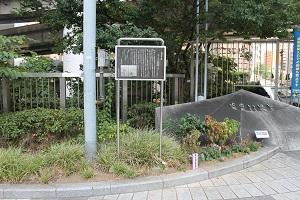
갑옷 다리 위에서 지바바시를 임한다.이 다리의 남조림 근처는 옛날에는 지바 강변이라고 칭해, 지를 잘라 쌓는 두는 장소였다.오늘의 지바초의 유래와 같이, 다리명도 이것에 유래한다.현재의 다리는 구교의 노후화로 1992년(1992)에 교체된 것(『모노시 백과』; 25)
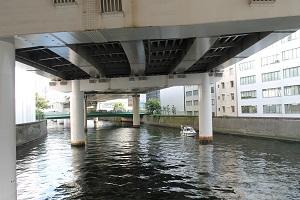
니혼바시코아미초에서 갑옷교 너머로 증권거래소를 임한다
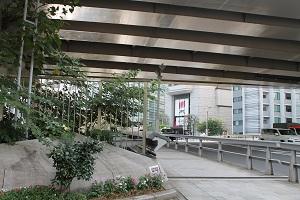
앞이 닛칸 빌딩, 그 앞의 수목은 투구 신사, 그 앞의 고층 빌딩은 니혼바시 다이아 빌딩
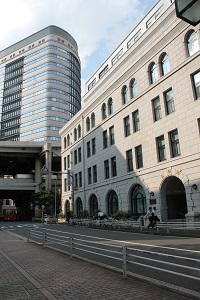
![]() .
.